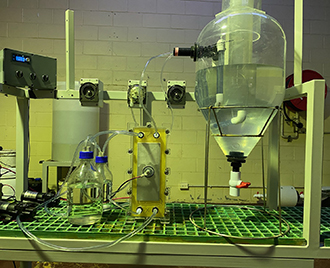- LithTech Industries’ magnesium separation technology aims to curb mining waste and give miners a new revenue stream.
- The process could help address lithium mining’s “global waste challenge” of 217 trillion liters of stored tailings.
- Magnesium separation may improve the sustainability of nickel, copper and cobalt mining.

Source: LithTech Industries
Australia’s LithTech Industries Pty. Ltd. launched a A$500,000 capital raise in May to fund the development of its patented magnesium separation technology that significantly increases the extraction of critical raw materials such as nickel, lithium, cobalt, copper and natural graphite.
The University of Queensland’s Dow Centre has endorsed the technology following successful lab-scale testing showing that it could recover 90%-95% of the lithium during the extraction process, compared to conventional methods that achieve 40%-45%.
LithTech now plans to have a commercial prototype ready for market by the first quarter of 2024. A listing on the Australian Securities Exchange slated for the third quarter of 2024 would finance its global expansion.
The process has the potential to boost production by increasing yields in jurisdictions with brine deposits, such as Argentina as well as Chile, which holds over 35% of the world’s lithium reserves, according to the US Geological Survey.
David Vinson, LithTech’s nonexecutive director, spoke to S&P Global Commodity Insights about some of the environmental and economic challenges miners face to feed the world’s decarbonization demands and LithTech’s plans to help address them. This interview has been lightly edited for clarity and space.
S&P Global Commodity Insights: What are some of the environmental problems associated with lithium that your team was trying to address?
David Vinson: Lithium mining and production have a number of environmental impacts, especially with regard to water use and contamination, particularly in brine deposits, which are often found in arid regions where water is already scarce.
Thus, lithium extraction from brines can lead to a depletion of groundwater resources and potentially contaminate local water sources because of the chemicals used in the extraction process, such as acids and solvents.
Magnesium interferes with the extraction processes and significantly reduces lithium recovery rates, which makes it one of the key contributors to the environmental impact, as mining companies need to use chemicals to mitigate magnesium’s effect on the purity of the lithium. … [It] co-precipitates with lithium as they behave similarly during the extraction and purification processes, which can make it difficult to separate the two elements.
To produce high-purity lithium products, magnesium and other impurities need to be removed from the brine, typically through a combination of chemical treatments and physical separation techniques, which increases the environmental footprint and production costs. It also impacts the economics of lithium production … which is not ideal when mining a high-demand resource with limited reserves.
How does LithTech’s method stack up against other waste solutions? Do you think any of these options will put an end to tailings in lithium mining
There are a number of technologies being developed to minimize the environmental issues of lithium extraction from brines, including Geo40 Limited to Lake Resources NL, and reduce the environmental footprint and use of chemical reagents in lithium production.
One of the key industry focuses is direct lithium extraction, which … is about removing evaporation ponds from the process, whereas LithTech is focused

Source: LithTech Industries
on magnesium separation, so we believe both technologies will complement each other in the development of a cleaner industry.
LithTech’s technology provides an alternative to disposing of the 217 trillion liters of tailings currently in storage worldwide. The process converts the mining waste into valuable byproducts, hydrogen and magnesium hydroxide, which could turn into potential revenue streams while also providing more water to put back into the mining process.
This use case for the technology creates a strong incentive structure for companies to reduce their tailings footprint, and we have already received strong interest from some major lithium companies.
It is impossible to know if we can put an end to mining tailings, but we believe LithTech’s technology provides an economically viable avenue to dealing with this global waste challenge and has the potential to significantly reduce its impact on the environment.
Could commercialization of your magnesium separation process also help copper, cobalt and nickel producers reduce mining waste and increase mine economics?
Magnesium is ubiquitous in mining and can impact the processing of copper, cobalt, nickel and other critical minerals. For example, during the processing of nickel laterite ores, magnesium can co-exist with nickel in the ore and can be present in the final product as a contaminant. This is particularly problematic in the production of high-purity nickel products, where even small amounts of magnesium can affect the quality of the final product.
Magnesium can also cause operational problems in the processing plant, as it can interfere with the separation of nickel from other metals during the extraction process. It also increases the viscosity of ore slurry, which can lead to difficulties in pumping and processing the ore.
In copper mining, the presence of magnesium in the ore can result in increased acid consumption during the leaching process, which can increase processing costs and reduce the overall recovery of copper from the ore.
Given the substantial challenges magnesium creates across the industry, LithTech believes it is well-placed to deliver a novel solution to an environmental and economic problem that mining companies want to be solved.
S&P Global Commodity Insights produces content for distribution on S&P Capital IQ Pro.